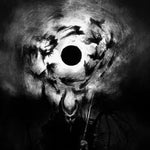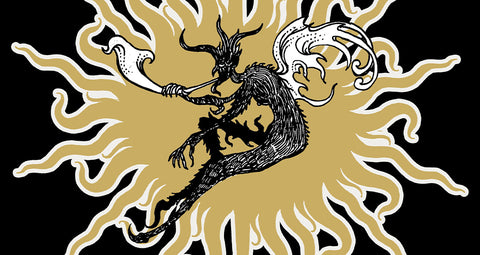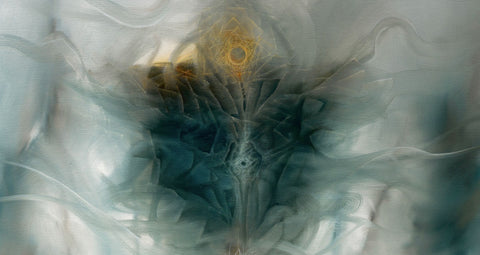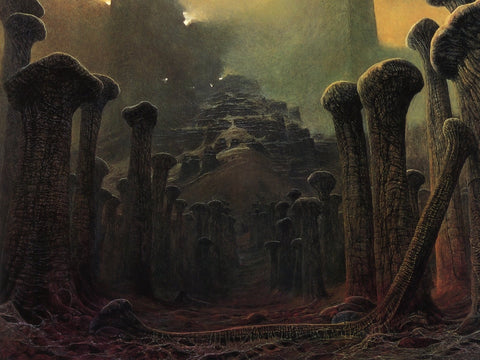
Electricity isn’t just a force — in the hands of VOLT IN HOLT, it becomes a brush, a scalpel, a searing signature of something primal. Based in the U.S. and Poland respectively, Dark Art & Craft presents VOLT IN HOLT original works through singular techniques, each driven by their own distinct creative vision: painting with electricity. By channeling raw current through photosensitive paper, the artist captures moments where chaos and control collide — like burn marks left by ghosts. We asked the artist eight questions about their haunting, high-voltage practice.
(Artist working with electrical discharge and photosensitive paper – Poland)
What was the first moment you realized that electricity could be a medium, not just a force?
During the first darkroom session. We intended it to be just an experiment to see what would happen. However, the moment the first fractal patches began to spread in the developer solution, we realized we were working with something of great potential that could lead us further. Initially, our focus was on observing the effects and having fun, but we soon found ourselves engaged in an experience that felt transcendental. At that moment, it was as if a new door had opened for us, and our minds became filled with ideas. We began to wonder what we could put on paper, how to arrange the objects, and we quickly started thinking about our future darkroom sessions.
It could be said that we knew from almost the very beginning that electricity could serve as our medium. Of course, we needed time to gain experience working with it deliberately. At first, we focused on experiments and spontaneous actions. Through careful observation and many attempts, we learned to predict some interactions with a “satisfactory degree of accuracy”. Thanks to this, we could move on to more intentional work, starting to plan more complex or just intended compositions.

γ-QUAERITO-3-513, 30,5 x 40,6 cm, 2022, Available on Dark Art & Craft
You’re literally burning light and voltage into paper — do you see your work as creation, destruction, or both?
A friend of ours once said that our works remind him of scars, because every burnout, where the pattern was formed and chaos was brought into order, came at the cost of some kind of damage. Indeed, our creative process is a hybrid of destruction and construction - creating chaos while simultaneously structuring it, all with a rough idea of the desired composition. The transformation from one state to another serves as the bridge on which we find ourselves and can act.
As individuals who engage with science on a daily basis, we often encounter the formation of fractal patterns in undesirable locations on high voltage components. While these patterns may reflect elements of creation, especially when visually appealing, a crucial aspect is missing: intentionality. We believe it is this intentionality that leads us to perceive our work primarily as creation. The fact that something had to be damaged in the process (paper or parts of the composition) lingers softly in the background. For us, the primary focus remains on creation.

γ-INSTILLO-513 (detail)
How much of your artwork is planned, and how much is chaos left behind by the current?
Let’s put it this way: the more minimalist the composition, the closer it stays to our original plan. As the composition becomes more abstract, more interactions emerge between the objects we use to create it, leading to greater surprises in the final outcome.
It all begins with an idea, followed by a concept or sketch of the composition. Then, we arrange it on photosensitive material in almost complete darkness. Everything matters here: not only what we place on paper or how the current interacts with it, but also various influencing factors - such as the parameters of the impulses we smoothly alter, the air humidity, and, above all, the inherent unpredictability of the phenomenon, which we might refer to as its "whims”. Electricity is like a cat - it walks its own path.
We have developed methods to have a greater impact on the composition, and nowadays we work through a multi-stage process. However, we must make decisions spontaneously... and in the dark. The final result remains a surprise until the work is developed.
Electricity is invisible — yet your work captures its presence. Do you consider your pieces a kind of evidence of something otherwise unseen?
The creative act is fundamentally the expression and embodiment of something invisible - our thoughts, ideas, and experiences seek an outlet and undergo a transformation into material form. In our technique, this process additionally merges with an invisible phenomenon. Numerous unseen factors come into play before we can perceive the final outcome. Therefore, the answer is: yes, definitely.

β-3-6-403, 40,6 x 30,5 cm, 2024
Who or what are some of your biggest influences — artistic, scientific, or otherwise?
A general inspiration, which serves as the foundation for the creation of our technique, was an old method of recording electrical discharges on dry plates. Scientists in the late 19th and early 20th centuries used it to observe the patterns outlined by discharges in order to check their characteristics. However, it was not intended for artistic purposes.
When it comes to everyday influences, music plays an invaluable role. It has the ability to create abstract landscapes in our minds, shaping our impressions and moods. We are immersed in music daily, and its influence often seeps from our subconscious into our conscious actions while planning and creating. Our listening preferences include darkwave, psychedelic doom, black metal, and dark ambient music.
How does the landscape or atmosphere of Poland influence your process or aesthetic?
Our studio/workshop is located in a bustling and noisy district of Warsaw, which is unfortunately too close to the airport. This environment is not beneficial to creativity and inspiration. To recharge, we often visit Paulina's hometown near the capital, where we enjoy walking in the forests and spending time in nature. Ultimately, we plan to move there so we can experience peace and quiet every day.

γ-QUAERITO-3-513 (detail)
What role do ritual, partnership, cooperation, or accident play in your work?
About the partnership/cooperation: In our duo, each person brings their own approach and knowledge, leading to the emergence of something new and surprising. Dominik is primarily responsible for the technical aspects and has extensive experience in the field of pulsed power. He built the entire setup, and his knowledge enables us to achieve the best possible results. We always discuss ideas together, as well as the materials and methods to use. We have to figure out how to fulfill the assumptions and imagine how the objects will behave in contact with electricity. Paulina is responsible for creating concepts, setting up the compositions, gathering materials, and handling the aspects that allow us to showcase our work to the world. Sometimes, we switch places - Dominik composes while Paulina operates the generator. As we work, we learn from our respective fields, allowing us to incorporate that experience into our future creations. The mind of an artist gains scientific knowledge, and the mind of a scientist gains artistic sensibility.
About the accident: An accident is an integral part of our creative process; it intertwines unexpectedly with our conscious actions and influences the final effect of the works.
About the ritual: Our entire practice and preparation for the session is like a multi-day
ceremony: discussing and summarizing the concepts, gathering materials, organizing the workshop, adapting it to darkroom conditions, setting up the discharge device, and taking a deep breath before turning off the lights. Then, we delve into the trance of creation.

δ-4-7-614, 61 x 50,8 cm, 2025, Available on Dark Art & Craft
What current Artists in any medium should we be checking out?
There are many artists whose works we follow with interest. Two who come to mind at the moment are Katja Lang and Nicola Samorì. Lang's works radiate a sense of coldness and melancholy, yet they also provide a soothing and engaging atmosphere, offering a moment of respite. In contrast, Samorì's works perfectly capture feelings of suffering and disturbance.
As we previously mentioned, music plays an important role in our lives, and we cannot
overlook the musicians who embody a dark atmosphere: Sad Madona, Mayflower Madame, Harsh Symmetry, Ritual Howls, Rezn, Whispering Sons, Isolated Youth, Electric Wizard, Nadja, Djevel, Grave Miasma, Azarath, Halo Manash - to name just a few.




